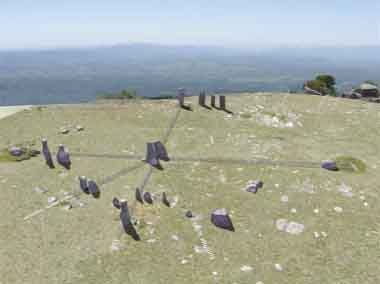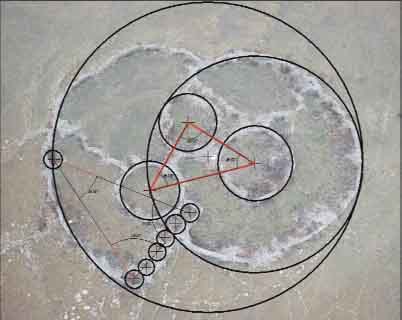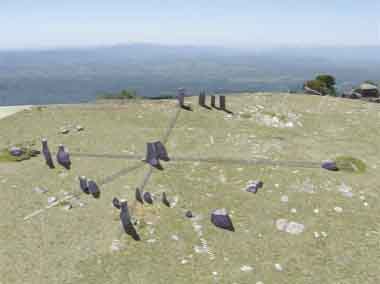
THE OLDEST MAN-MADE STRUCTURES ON EARTH
Scholars have told us that the first civilisation on Earth emerged in a land called Sumer some 6,000 years ago. Recent archaeological findings suggest that the Sumerians may have inherited some of their knowledge from an earlier civilisation that emerged many thousands of years earlier in southern Africa, the cradle of humankind. More than 100,000 years ago, early humans built a stone calendar that precedes all other man-made structures found to date. This discovery is so astounding that it requires a true paradigm shift in our approach to ancient human activity, as it takes us closer to the emergence of the earliest humans on planet Earth
This "African Stonehenge", which we call Adam's Calendar, has created for the first time a link to the countless other stone ruins in southern Africa and suggests that these ruins are much older than we thought. The complex that links Waterval Boven, Machadodorp, Carolina and Dullstroom covers an area larger than modern-day Johannesburg and has emerged as the largest and most mysterious ancient city on Earth. The discoveries of petroglyphs of winged discs and carved dolerite statues of giant birds, some resembling the hawk-headed god Horus, suggest that the prototype Sumerian and Egyptian civilisations had their origins in southern Africa thousands of years before they emerged in the north.
Seven years of research by a group of independent scientists and explorers has delivered what may be the crucial missing elements in our understanding of the lives and development of early modern humans. Their discoveries have been released in the book Adam's Calendar, co-written by this author and Johan Heine (Zulu Planet Publishers, 2008). However, the research has also shown that these stone settlements represent the most mysterious and misunderstood structures found so far. It points to a civilisation that lived and dug for gold in this part of the world for thousands of years. If this is in fact the cradle of humankind, we may be looking at what's left of the workings of the oldest civilisation on Earth.
Johan Heine manages the largest group of fire-fighters and fleet of firefighting aircraft in Africa. As a pilot, he has been flying over the mountains of Mpumalanga for over 20 years. He instantly took a keen interest in the thousands of strange circular stone ruins that lie scattered throughout this region and he started photographing them. In consulting various so-called experts on their origins, he was informed that these are merely the remains of "cattle kraal" left behind by the Bantu people when they migrated from the north around the 14th century until about the 18th century. But it was an air crash involving one of his crew that brought Johan to discover the mysterious monolithic circle which we now call Adam's Calendar and put the entire mystery of these ancient ruins into perspective.
Adam's Calendar is positioned along the same 31-degree longitudinal line as Great Zimbabwe and the Great Pyramid of Giza.

In 2003, Johan spotted the strange monoliths standing upright in the centre of a larger eroded circular structure right on the edge of a high mountain cliff (figure 1). After dealing with the crashed aircraft and recovering the pilot, who was only suffering from a broken arm, Johan returned to investigate the monoliths. He also brought at least five academics to the site in search of explanations—and this is when he found out how amazingly blind "those who will not see" can be. Not one of them could see the true significance of the discovery, claiming that these were just random stones. This was a big blow to his original excitement, but like a true explorer he did not stop there. The site is situated on the edge of what is known as the Transvaal Escarpment, which geologically consists of the Black Reef Quartzite Formation that's rich in gold. (Incidentally, this is where gold prospecting started in the early 1800s.) But the monoliths of Adam's Calendar are all dolerite. The closest vein of dolerite is about a kilometre away from the site. This means that the architects went to a lot of trouble to transport the monoliths, some of which weigh over five tonnes, to the site. The central monolith is carved with such precision as to allow the setting sun to cast a shadow on what we call the "flat calendar stone".
Johan began to measure and calculate the layout and parameters of the monoliths. Informed by his years of experience in aeronautical science and navigation, he very quickly realised that the circular structure was purposefully designed and aligned with the cardinal points of the Earth as well as the equinoxes and solstices.

However, it took another six years and many more explorations of amazing new discoveries on every trip to the mountain-top before the site was accurately surveyed and the true age of the monoliths was revealed. It turned out that the north–south, east–west alignment is out by 3 degrees 17 minutes 43 seconds. This means that we are dealing with a structure at least 25,000 years old, based on archaeoastronomic calculations relating to the 26,000-year cycle of the precessional wobble.
Further studies of the geology, erosion, stellar alignments and lichen growth have allowed us to reach a reasonably sound and scientific conclusion that this site is at least 75,000 years old. Our latest research has pushed back this date to well over 100,000 years.
Mysterious Stone Ruins
It is generally estimated by scholars that there are about 20,000 ancient stone ruins scattered throughout the mountains of southern Africa (figures 2 and 3). Modern historians have been speculating about the origins of these ruins, often calling them "cattle kraal of little historic importance". The truth of the matter is that closer scientific inspection paints a completely different and astonishing new picture about the ancient history of these stone ruins of southern Africa. The scientific reality is that we actually know very little about these spectacular ancient ruins, and it is a great tragedy that thousands have already been destroyed through sheer ignorance by foresters, farmers and developers. After my personal explorations on foot and by air over the past two or more years, I can confidently estimate the number of ancient stone ruins to be closer to 100,000—a figure confirmed in January 2009 by retired archaeology professor Revil Mason.
The Population Problem
This finding immediately poses a huge problem for archaeologists, anthropologists and historians because the accepted history of this part of the planet does not place, at any time in our past, anywhere nearly enough people here to have built this number of structures. It gets even more complex when you realise that these were not just isolated structures left behind by migrating hunter-gatherers. The true reality hits you when you take in the magnitude and expanse of these settlements and witness the staggering number of ancient terraces that surround these settlements which cover over 450,000 square kilometres and possibly much more in southern Africa. Detailed archaeological scrutiny of photographic evidence of these terraces shows some to be at least 5,000 years old (figure 4).
.jpg)
The complex that links Waterval Boven, Machadodorp, Carolina and Dullstroom covers around 20,000 square kilometres, which is an area larger than modern-day Johannesburg. Most of the original settlement structures are well buried beneath the soil and can only be seen from the air by a trained observer.
The picture gets even more confusing when you observe the ancient roads that link all these settlements together. We have traced the remains of these roads that can still be seen stretching to a distance of about 500 kilometres. In their original state, they would have covered thousands of kilometres. The positions of the ancient road sections that we have discovered suggest that this network once ran continuously from the coast of Mozambique to Botswana and possibly beyond. A rough calculation shows that just the visible pieces of the original ancient roads would have required over 500 million stones, each weighing between 10 and 50 kilograms, to construct. If we assume that the roads make up only two per cent of the ancient settlements, the number of stones required to build the entire ancient city/settlement becomes unthinkable. This simply would not be possible with the current population model of ancient civilisation in southern Africa. The other issue we need to deal with is the need for roads, since previously it was believed that the wheel only arrived in this part of the world with Portuguese explorers in the 1500s.

The Oldest City on Earth
It would not be unthinkable that we are possibly looking at the oldest settlements on Earth. Artefacts that have been recovered from these ruins show a long and extended period of settlement that spans well over 200,000 years. Over the past three decades, several researchers have raised this issue, only to be ridiculed and often ostracised. Many leading scientists and historians have since voiced their support for such ancient origins. Since southern Africa is the cradle of humankind, we should not be surprised to find such ruins but, rather, we should expect these discoveries. The reality seems to be that we are dealing with what is possibly the largest and least understood ancient civilisation on Earth. It's important to note that the mysterious ruins of southern Africa, which include Great Zimbabwe and thousands of similar ruins in that country, also extend into neighbouring areas such as Botswana, Namibia, Zambia, Kenya and Mozambique. But why were these ancient people here in the first place? What were they doing?
Ancient Gold Fields
The past 200 years has seen a number of explorers write in great detail about these ruins, but their findings have been largely forgotten and their books are out of print. Most of these early explorers wrote about thousands of ancient mine shafts found in close proximity to the ruins. These mines have been described as sources of gold, copper, tin and iron. In my personal experience and research, I have found at least five ancient mine shafts in gold-rich areas and have been told of dozens more by farmers of the region. It seems that gold-mining has been going on here for a lot longer than most of us ever imagined.
In 1891, a coin issued by Roman Emperor Antoninus Pius in AD 138 was found 25 metres deep in a gold mine by Theodore Bent, who conducted the first excavation of Great Zimbabwe. The Egyptian Pharaoh Ramesses II (1279–1213 BC) wrote about crossing the African continent to its southern tip and of his encounters with gold in this part of the world. It becomes evident that these are probably the fabled mines of King Solomon.
Should we be surprised by this discovery? The oldest written records of human history, the Sumerian tablets, describe extensively the ancient activity in a land called Abzu—the land below the equator where the gold was mined. The tablets describe the early human settlements and the quest for gold. The fact that many scholars keep ignoring these scripts is a great pity.
The links with the Sumerian civilisation in southern Africa simply cannot be ignored or erased. They can even be traced etymologically in the names and origins of indigenous people. The most obvious piece of evidence that has never been explained is the word Abantu, the name commonly used to describe black South Africans. According to the pre-eminent shaman and medicine man Credo Mutwa, the name is derived from the Sumerian goddess Antu. Abantu simply means "the children or people of Antu".
The Orion Connection and the Horus Hawk Statue
The monolithic Adam's Calendar is the flagship among these southern African ruins because we can date it with relative certainty to at least 75,000 years of age, based on a number of scientific evaluations. In turn, it points to the diverse ancient history of southern Africa and presents the first tangible evidence of the earliest humans in the "cradle of humankind". The remarkable calendar was originally a large circular stone structure resembling but pre-dating Stonehenge by many thousands of years. Its original shape is still clearly visible from satellite images. Adam's Calendar is positioned along the same 31-degree longitudinal line as Great Zimbabwe and the Great Pyramid of Giza. Three of the monoliths are aligned with Orion's belt when the constellation rose horizontally on the horizon at least 75,000 years ago. The latest astronomic calculation suggests that the last time Orion would have been flat on the horizon was around 160,000 years ago. A recent observation is that the fallen monolith on the outer circle that marks the vernal equinox sunrise is shaped like the Horus hawk head from Egypt and also resembles the bird statues found amongst the ruins in Zimbabwe. This is the oldest statue of the Horus hawk by a long shot, and should attract great interest in the years to come.
...we are possibly looking at the oldest settlements on Earth. Artefacts that have been recovered from these ruins show a long and extended period of settlement that spans well over 200,000 years.
Rewriting Human History Southern Africa holds some of the deepest mysteries in all of human history. Although much has been written about the first humans who appeared in this part of the world, we have found very little evidence of their activities and what kind of lives they led from around 250,000 to 75,000 years ago. What we are told is that around 60,000 years ago the people from Africa began to migrate north and eventually populated the whole planet. Who were these first humans? What did they do? How did they live? And where did they disappear to?
The first signs of human intelligence and consciousness only appeared around 75,000 years ago, when the Khoisan people of southern Africa started leaving behind an array of spectacular cave paintings all over this part of the continent. Finely crafted beads and bracelet fragments found at Blombos Cave in South Africa's Western Cape show that these early humans had already developed a feel for the arts and crafts. The legends become even more vivid when we learn about the great empire of Monomotapa, which arguably was at its height around AD 1000 and whose kings were powerful and wealthy in gold. When we move back to around 1000 BC, we encounter the mysterious Queen of Sheba, who ruled a kingdom in the lost land of Ophir that was teeming with endless supplies of gold, and the wise and wealthy King Solomon, who seduced her and obtained all his gold from her. Is it possible that there actually was such a place? Was it really filled with limitless wealth in gold? Was it here that the wealthiest kings on Earth mined their gold?
Ophir is an etymological derivative of the ancient place called Afer, "where the gold came from"; then it became the Arabic Afir, for Africa, from which was derived K'Afir, which became the slang word for black people in later years. In the Bible, it was changed to Ofir or Ophir. There seems to be a clear link between all these places, and this link leads to southern Africa— where the gold came from.
This is, after all, the place where most of the world's gold has been mined in modern history, and it was no different in ancient times. Is it a coincidence that the richest gold mine in the world today is the Sheba Gold Mine, located right here in Mpumalanga, South Africa? These may seem like naïve questions to some, but after personally exploring the remnants of enormous ancient cities and civilisations in southern Africa I am convinced that what we think we know about our ancient human history is further from the truth than we ever imagined. Adam's Calendar firmly places the many ancient ruins of southern Africa at a point in history some 100,000 years ago that we modern humans have never faced before. It takes us further back in time, closer to the emergence of Homo sapiens, than any other structure ever found to date, and it will force historians and archaeologists to reconsider ancient human activity and consciousness.
About the Author:

Michael Tellinger has had a 30- year obsession with the origins of humankind. He graduated from the University of Witwatersrand, Johannesburg, in 1983 with a Bachelor of Pharmacy degree and a passion for the cosmos, genetics, human history and music. Before he began his research/writing career, he was an acclaimed musical performer and songwriter in South Africa and then a sound designer and editor based in Los Angeles, USA. He has also worked as an actor, a screenplay writer and a radio/TV producer/ presenter specialising in science and technology. Tellinger set up his own publishing company, Zulu Planet Publishers, and is the author of Slave Species of god (2005), Adam's Calendar (with Johan Heine, 2008) and Temples of the African Gods (also with Johan Heine, 2009; see review in this edition). He is a member/director of the MaKomati Foundation, a non-profit organisation established in 2003 to research, protect, maintain and promote the ancient ruins of Mpumalanga in South Africa.
Michael Tellinger can be contacted by email here publisher@zuluplanet.com.
For more information, visit the websites: www.adamscalendar.com - www.slavespecies.com
www.makomati.org - www.zuluplanet.com . Article published in June–July 2010 Nexus magazine www.nexusmagazine.com.
http://www.megalithomania.co.uk/michaelarticle.html
